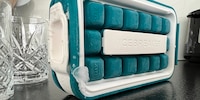

Golyo ice cube mould: pricey, but the best I’ve ever tested
I like always having a few ice cubes ready in the freezer. Only, preparing and popping them out is really annoying. Thanks to the Golyo’s shape, it’s now way easier.
Almost 300 ice cube moulds are available in our range. None of them were good enough for Roman Isliker. So, the Swiss inventor, an ex-IT employee at a bank, developed an ice cube mould himself in 2023, launching a Kickstarter campaign. I received a pre-release model a few months ago. And without spoiling my verdict, this thing’s cool in more than one way!
Shape and material
The Golyo ice cube mould is made of platinum silicone, which is increasingly being used in the food and medical applications. Although the name suggests otherwise, platinum silicone doesn’t contain any precious metal. Platinum is merely a catalyst in the manufacturing process. It accelerates the synthesis of silicone during vulcanisation and makes the product more stable. Silicone produced in this way is more durable, doesn’t release harmful chemicals or odours and doesn’t eventually break down into harmful microplastics. Theoretically, the ice cube mould can even be used to make baked goods. But I haven’t tested that yet.
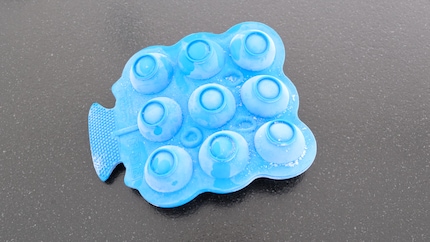
Source: Martin Jungfer
Weighing in at 250 grammes, the Golyo mould fits comfortably in my hand, unlike those rectangular ice cube moulds made of cheap plastic that you get for free with every refrigerator.
The whole thing’s 18 centimetres wide, 22 long and 5 high. It consists of two halves that are pressed together, once at the edge and by three fittings in the middle. The whole thing’s very solidly made and has a strong seal. You can fill the clicked-together mould with just under half a litre of water. The whole thing’s divided into nine balls, half a decilitre each.
Filling and emptying
I fill my Golyo mould at the kitchen tap, similar to a hot-water bottle. Instead of using a screw cap, I simply push the opening slightly apart and let the water run in. It’s easy to tell when the mould is full. I then lay it flat on the shelf next to the sink and squeeze out some excess water. How much? That’s up to you. After a few rounds of ice making, I got the hang of it. Of course, you can also use a measuring cup to add the exact 480 millilitres. A short instructional video, which can be found via a QR code in the instructions, also provides help if required. Or you can watch it directly here.
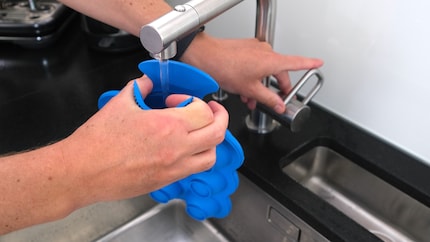
Source: Martin Jungfer
Now I just need to click the neck shut, then the mould can be placed in the freezer. One advantage of the Golyo mould is that it’ll stay firmly and tightly closed. That way I don’t spill any water when transporting it from the sink to the freezer. On top of that, I don’t have to spend time looking for a free horizontal space between the ice cream and spinach. It also fits upright – like a book on a shelf. The Icebraker Pop shape, which I’ve also tested ([read here]( /page/ice-ice-baby-was-taugt-der-icebreaker-pop-im-praxis-test-24062)), is similarly flexible. Generally speaking, sealed moulds ensure less excess ice.
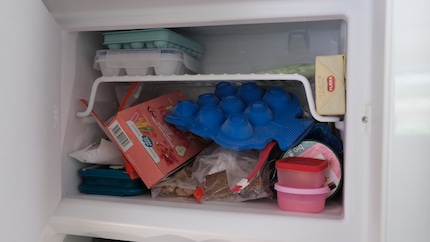
Source: Martin Jungfer
After a few hours – depending on the temperature of the water you used – the ice balls will be ready for use. To get them out of the mould, I simply lift off one half, and nine well-formed ice balls with a proud diameter of four and a half centimetres lie before me. If I put too much water in the mould beforehand, there’ll be extra ice between the balls. If there was too little water, the balls won’t be fully formed. Both are more of an aesthetic problem than a functional one.
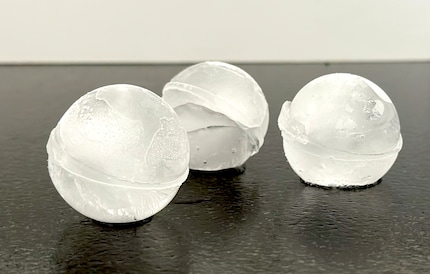
Source: Martin Jungfer
I like the fact that the balls simply pop out when I press lightly on the mould next to the ball. I leave the rest where they are and close the mould again before it goes back in the freezer. Turns out I could even refill the voids with more water; in this case it’s advisable to remove the balls that are close to the filler opening first.
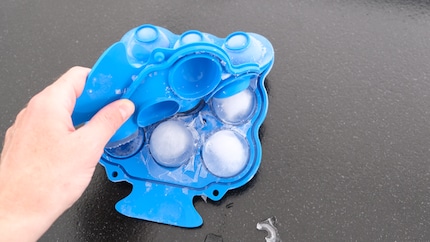
Source: Martin Jungfer
Balls cool better
Normally, one ball is enough for a glass of iced tea or a Sanbitter. After all, a sphere is the geometric shape with the smallest surface area in relation to its volume. This cools liquids longer since it melts more slowly and your drink won’t be watered down.
Oh, in case you’re still wondering where the name Golyo comes from, it’s simply the Hungarian word for ball. Useless knowledge to show off at your next aperitif.
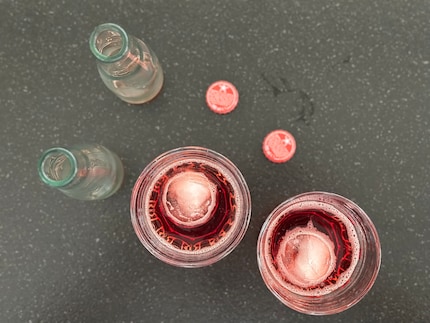
Source: Martin Jungfer
Fancy seeing the balls floating in a drink now? Just watch the video below.
In a nutshell
A well-rounded affair!
Pro
- Refillable, even if there’s still ice in the mould
- Can be placed in the freezer as required
- Large balls cool better than cubes
- Very easy to fill and remove
- High-quality platinum silicone
Contra
- Big ice balls take some getting used to

Journalist since 1997. Stopovers in Franconia (or the Franken region), Lake Constance, Obwalden, Nidwalden and Zurich. Father since 2014. Expert in editorial organisation and motivation. Focus on sustainability, home office tools, beautiful things for the home, creative toys and sports equipment.
